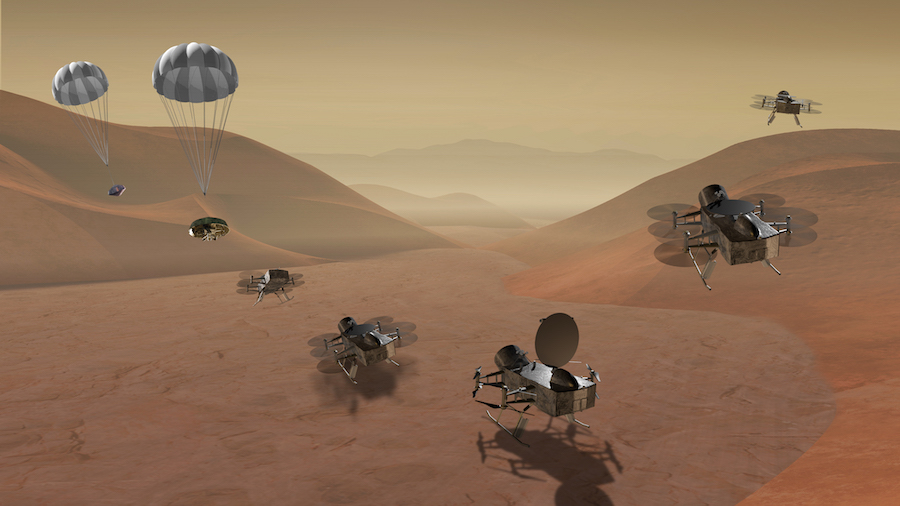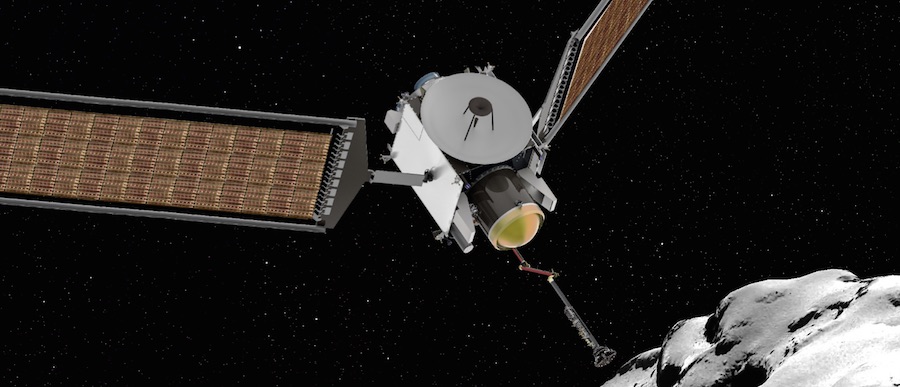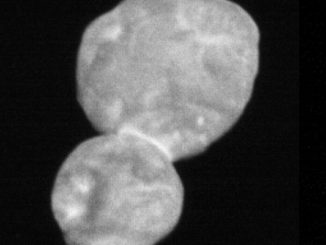
NASA has narrowed its choices for a new billion-dollar robotic space mission: A nuclear-powered quadcopter to explore the hazy landscape of Saturn’s largest moon Titan, or a probe to scoop up a piece of a comet and return it to Earth.
The space agency announced its selections Wednesday, picking two concepts from 12 proposals submitted by scientists earlier this year in a competition to win government funding to build and launch a mission by the end of 2025.
The teams behind the Dragonfly mission to Titan and the CAESAR mission to comet 67P/Churyumov-Gerasimenko will receive $4 million from NASA over the next year to refine their plans and designs, setting the stage for NASA to decide in July 2019 which mission will go forward to launch.
The winner will become the fourth mission in NASA’s New Frontiers program, a series of science-driven solar system probes cost-capped at about $1 billion that has so far produced the New Horizons mission to Pluto, the Juno orbiter at Jupiter, and the OSIRIS-REx spacecraft on the way to snag a sample of an asteroid and bring it back to Earth.
The Dragonfly mission would reach Titan in 2034, descend through its thick atmosphere and deploy a rotorcraft to make multiple hops across the moon’s alien surface over a two-year mission, surveying dune fields and rivers and lakes of liquid methane and ethane in search of the building blocks of life.
“Titan is a unique ocean world,” said Elizabeth Turtle, principal investigator for the Dragonfly mission at the Johns Hopkins University Applied Physics Laboratory. “It has a dense atmosphere, with very complex hydrocarbons produced in the atmosphere and littering the surface.
Most of what scientists know about Titan came from NASA’s Cassini spacecraft and a European Space Agency probe named Huygens, which made the first landing on Saturn’s largest moon in 2005.
Cassini made 127 flybys of Titan in its 13-year tour of Saturn before its mission ended in September, unveiling the moon’s surface for the first time to see oceans with rugged shorelines, streams and sand dunes. NASA’s Voyager probes could not see through Titan’s hazy veneer when they flew by Saturn in 1980 and 1981.
“It has lakes and seas of liquid methane and ethane, and rivers that flow across the surface, and what we’re excited to continue with this mission concept is to build upon the Cassini-Huygens exploration of Titan with Dragonfly, which is a rotorcraft lander,” Turtle said Wednesday.
“Unique about Titan is that it’s got a liquid cycle very much like Earth’s water cycle, but it’s with methane,” said Peter Bedini, Dragonfly project manager at the Applied Physics Laboratory in Laurel, Maryland, where the craft would be designed and built.
But many questions about Titan remain unanswered. It’s the solar system’s only moon with a dense atmosphere — made primarily of nitrogen and methane — but Titan’s orange haze hides its surface from conventional cameras.
Cassini peered through the atmosphere with an imaging radar to reveal huge land masses, oceans and other surface features.
But Cassini and Huygens “left us with a lot of fundamental unknowns,” Turtle said. “We don’t know the basic composition of the solid surface on Titan. We have some information from spectral characteristics from orbit. We have some information from the Huygens probe, but neither (Cassini nor Huygens) was designed or able to do detailed measurements of the kind of rich organic chemistry that we know is occurring there. So Dragonfly is designed to go back to build on what we’ve learned from Cassini-Huygens and answer the fundamental unknowns that remain about Titan.”
The Dragonfly drone would carry cameras, drills, seismic and weather sensors, and spectrometers to examine the composition of Titan’s rocks and soil, collecting four basic types of measurements. A plutonium power source, known as a Multi-Mission Radioisotope Thermoelectric Generator, or MMRTG, would charge the craft’s batteries to power the instruments, eight electrically-driven rotors and a high-gain antenna to beam data directly to Earth.
Dragonfly’s mobility is a key advantage, officials said, allowing it to travel tens to hundreds of kilometers across Titan, Turtle said.
“In this way, we can evaluate how far pre-biotic chemistry has progressed in an environment that we know had the ingredients for life — for water-based life, or potentially even hydrocarbon-based life,” she said.
“When you first hear the high concept of Dragonfly, it might seem a little ambitious, or maybe even a little audacious,” Bedini said in a presentation earlier this year.
A flying drone would allow scientists to explore a wider range on Titan, first touching down in a relatively flat region before departing to more interesting — and hazardous — locations to land and conduct observations for weeks at a time, then moving on again.
“We could take a lander and we could plop it down on Titan, and we could take these four measurements at one place, and we would significantly increase our understanding of Titan and … bodies like it and other ocean worlds,” Bedini said. “However, we can multiply the value of this mission if we add aerial mobility because now we can look at this very diverse surface that is Titan. It’s got a variety of geologic settings. Instead of just measuring in one place, we can go to many places and increase the science return substantially.”
And unlike a rover on the surface, an instrumented drone would not be stopped or delayed by obstacles like rocks and steep slopes.
Titan’s thick atmosphere makes getting down to the ground tricky, but once there, flying a drone should be feasible.
“It turns out that the easiest place in the solar system to fly a quadcopter is on Titan,” Bedini said. “That’s because Titan’s got an atmosphere more than four times as dense as Earth, and the gravity is only one-seventh that of Earth.”
The other New Frontiers finalist — the Comet Astrobiology Exploration Sample Return mission, or CAESAR — would embark on a round-trip journey to comet 67P/Churyumov-Gerasimenko, revisiting the same comet explored by the European Space Agency’s Rosetta mission from 2014 through 2016.
The CAESAR mission concept is led by Steve Squyres, a professor of astronomy at Cornell University and lead scientist for NASA’s Spirit and Opportunity rovers on Mars.
After launching in the mid-2020s, CAESAR would depart toward comet 67P powered by solar-electric thrusters and armed with an extendable collector to capture at least 100 grams, or 3.5 ounces, of material from its icy nucleus.
Built by Orbital ATK, the spacecraft would bring the specimens back to Earth for scientists to analyze in ground-based labs. While NASA’s Stardust mission brought back dust grains from the coma of a comet in 2006, samples from a comet’s nucleus have never been returned from space.
“Comets are among the most scientifically important objects in the solar system, but they’re also among the most poorly understood,” Squyres said Wednesday.
“They’re the most primitive building blocks of planets,” he said. “They contain materials that date from the very earliest moments of solar system formation, and even before. Comets were a source of water for the Earth’s oceans, and critically, they were a source of organic molecules that contributed to the origin of life.”

CAESAR would approach comet 67P for touch-and-go maneuvers to retrieve two types of samples: volatile and non-volatile material.
Frozen volatile compounds, like water ice, are heated when comets get close to the sun, spewing jets of dust and gas dozens of miles into space.
“What makes comets really special, what distinguishes them from every other primitive body out there, is what we call their volatile components,” Squyres said. “The ices, the volatile organic compounds, just aren’t present in any other kind of planetary body.”
The two types of samples would be separated into different chambers inside a re-entry capsule that would return to a parachute-assisted landing in Utah in November 2038.
“Patience is a virtue in this business,” Squyres said.
The return canister would be provided by the Japan Aerospace Exploration Agency, based on the design employed on Japan’s Hayabusa asteroid sample return mission, which landed in 2010.
“Of course, the end date of the flight is really just the beginning of the mission,” Squyres said. “That’s the beginning of the mission science, when those samples come back, and the science will extend for decades.”
Squyres said going back to comet 67P/Churyumov-Gerasimenko will give mission planners an idea of what to expect at the destination ahead of time.
“By going to that comet, there’s an enormous amount of risk reduction that takes place because we’re going to an object that we’ve already got good maps of,” Squyres said.
“The reason that we’re going to Churyumov-Gerasimenko is that it provides us with an enormous amount of information about how to conduct our mission,” he said. “Churyumov-Gerasimenko has been mapped in detail by the Rosetta mission, so we are able to design our mission, our spacecraft, specifically for the conditions that we know to exist there.”
Squyres said he will step down as lead scientist on the Opportunity rover mission, which still operates on Mars nearly 14 years after its arrival, if NASA picks CAESAR for development and launch.
Thomas Zurbuchen, head of NASA’s science mission directorate, told reporters Wednesday he selected Dragon and CAESAR based on their scientific and technical merits.
“I selected these mission concepts based on their outstanding and visionary science, as well as the endorsement of our rigorous selection process that looks at both scientific and technical viability,” Zurbuchen said.
The 12 proposals submitted to NASA in April focused on six themes outlined by the National Academy of Sciences:
- Comet Surface Sample Return
- Lunar South Pole-Aitken Basin Sample Return
- Ocean Worlds (Titan and/or Enceladus)
- Saturn Probe
- Trojan Tour and Rendezvous
- Venus In Situ Explorer
The winning mission selected in 2019 will have a cost cap of $850 million, a figure that does not include the cost of a launcher or operations, which will likely drive the project’s total budget above $1 billion.
NASA is expected to pick a launch vehicle for the next New Frontiers mission in the early 2020s.
The space agency will fund further technological research on two other proposals that did not make Wednesday’s cut.
A team that proposed sending a robotic mission named ELSAH to search for biosignatures at Saturn’s moon Enceladus will receive additional NASA funding develop ways to achieve stringent contamination controls for life detection. Scientists who worked on the VICI proposal — a twin-lander mission to Venus — will also get support in advancing technologies that can withstand the extreme pressures and temperatures at the planet’s surface.
Email the author.
Follow Stephen Clark on Twitter: @StephenClark1.



